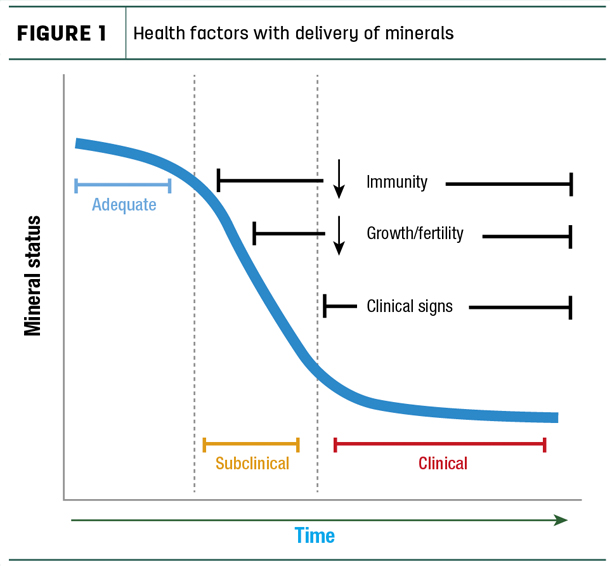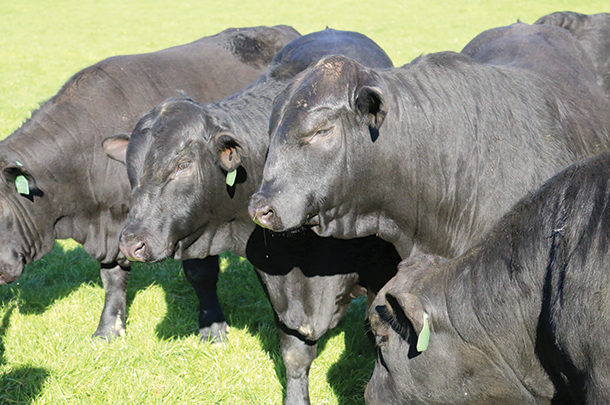Proper management, with an emphasis on nutrition, will help you maximize the performance of your bulls. Below are three key areas to monitor prior to turning out your bulls. After all, as the saying goes, failure to prepare is preparing to fail.
1. Conditioning bulls
The body condition of the cow herd should be monitored, as should the condition of the bulls. Whether they are young, first-season bulls or older, more experienced bulls, condition is key to maximizing their performance. Ideally, based on the U.S. scale of 1 to 9, bulls should be at a body condition score (BCS) of 6 at turnout, going into breeding. BCS should be monitored throughout the year. For every point of change in BCS, 80 to 100 pounds of weight should be put on (or taken off) – but this should be done over time. Allowing bulls to put on weight over a longer term, versus drastic weight changes in a short amount of time, will be more beneficial to the overall longevity and performance of the bull.
It is also important to monitor bull activity during the breeding season. For example, if bulls must cover large pastures, make sure they are getting the energy and nutrients needed to hold their BCS throughout the breeding period. If their condition falls below a score of 4, their performance may be compromised, and it may be necessary to replace that bull for the end of the breeding period. Also, keep in mind that bulls 3 years old and younger are still growing, so proper nutrition is critical for their longevity.
2. Breeding soundness exam
For most cow-calf producers, overall profitability starts with high pregnancy rates and a high percentage of calves being conceived early in the breeding season. Sound, highly fertile bulls are a critical component of reproductive success.
It is important to confirm that bulls are fertile and sound prior to the breeding season, at least 45 to 60 days prior to turnout. When bulls are guaranteed to be sound at the time of purchase, if there does end up being a problem, there will still be time to work with the breeder or to find a replacement. Keeping bulls in the proper plane of nutrition year-round may help alleviate potential problems – but factors that are out of your control could still keep the bull from performing at his full potential. A typical soundness exam includes:
- A general physical examination of the bull’s nutritional status (body condition)
- Evaluation of any structural defects or disease conditions that would affect feet and leg soundness, which can negatively impact the bull’s breeding performance
- Evaluation of eyesight and teeth
- Examination to ensure the internal structures of the reproductive system are normal
- Examination of the external structures of the reproductive system, including scrotal circumference measurements
- Semen evaluation, including sperm motility and morphology
Contact your veterinarian to set up a breeding soundness exam and to inquire about their recommendations for testing for infectious diseases, such as trichomoniasis.
3. Mineral nutrition
Mineral supplementation is an essential management tool for achieving the performance you expect from your bulls. As you sort through bulls, looking for ways to maximize the genetic potential of your herd, prioritizing proper nutritional needs should be sorted to the top. If demands and requirements aren’t met, the genetic potential of your herd sire will fall short, and their performance may be subpar.
What happens when mineral status is not met over time? As a result, some important health factors are compromised, as is illustrated in Figure 1.

Even if your bull appears visibly healthy, some subclinical signs may remain unseen, resulting in production losses. You can avoid this loss in productivity through proper mineral supplementation. Trace minerals – including zinc, copper, manganese and selenium – play a key role in reproductive success. For the best results, year-round mineral supplementation is recommended. In fact, the process of spermatogenesis (the formation of sperm cells) begins an average of 61 days prior to breeding, and research has confirmed that semen quality is directly impacted by mineral nutrition.
- Zinc plays an important role in immune function as well as the synthesis of testosterone. Zinc supplementation has been shown to increase ejaculate volume, sperm concentration and motility in bulls. Furthermore, chelated/organic sources of zinc supplementation resulted in more improved fertility than did inorganic sources alone.
- Copper is necessary for enzyme function, including protecting sperm cells against free radicals. Copper deficiencies may lead to a decrease in libido and semen quality and may delay the onset of puberty in young bulls.
- Manganese is necessary for cholesterol synthesis and is required for hormones such as testosterone. Insufficient hormonal production may result in abnormal sperm production in bulls.
- Selenium improves semen quality through increased volume, motility and concentration while decreasing the percent that is dead or damaged. Selenium also plays a role in reducing oxidative stress throughout the internal system and specifically protects spermatozoa from oxidative stress. Studies have also revealed an increase in scrotal circumference and testosterone secretion when selenium is supplemented.
If you expect the most from your bulls, you must also provide them the best care possible. A high-quality mineral program, combined with best management practices, will ensure reproductive performance that delivers. ![]()
PHOTO: As you sort through bulls, looking for ways to maximize the genetic potential of your herd, prioritizing proper nutritional needs should be sorted to the top. Photo by David Cooper.
References omitted but are available upon request. Click here to email an editor.

-
Jill Peine
- Research and Nutrition Services
- Ridley Block Operations
- Email Jill Peine







